Analysis of the Ability to Produce Pleasant Aromas on Sour Whey and Buttermilk By-Products by Mold Galactomyces geotrichum: Identification of Key Odorants
Abstract
1. Introduction
2. Results and Discussion
2.1. Optimization of Culture Conditions
2.1.1. Type of Sugar
2.1.2. pH Value
2.1.3. Incubation Temperature
2.1.4. Determining of Culture Conditions
2.2. Sensory Evaluation of Flask Cultures
2.3. Identification of Key Aroma Compounds in a Post-Fermentation Product Using GC−O Analysis and Calculation of OAVs
3. Materials and Methods
3.1. Chemicals
3.2. Microorganisms
Preparation of the G. geotrichum Strain
3.3. Determining the Optimal Culture Conditions
3.3.1. Type of Sugar
3.3.2. pH Value
3.3.3. Incubation Temperature
3.4. Sensory Evaluation
3.5. Flask Cultures
3.6. Extraction of Volatile Compounds from Post-Fermentation Product Using the Solvent-Assisted Flavor Evaporation (SAFE) Method
3.7. GC-O and GC-MS Analysis
3.7.1. Gas Chromatography-Olfactometry (GC-O)
3.7.2. Gas Chromatography-Mass Spectrometry (GC-MS)
3.8. Quantitation by Stable Isotope Dilution Assays (SIDA)
4. Conclusions
Author Contributions
Funding
Institutional Review Board Statement
Informed Consent Statement
Data Availability Statement
Conflicts of Interest
References
- Bicas, J.L.; Silva, J.C.; Dionísio, A.P.; Pastore, G.M. Biotechnological production of bioflavors and functional sugars. Ciência Technol. Aliment. 2010, 30, 7–18. [Google Scholar] [CrossRef][Green Version]
- Longo, M.A.; Sanromán, M.A. Production of Food Aroma Compounds: Microbial and Enzymatic Methodologies. Food Technol. Biotechnol. 2006, 44, 335–353. [Google Scholar]
- Sales, A.; Paulino, B.N.; Pastore, G.M.; Bicas, J.L. Biogeneration of aroma compounds. Curr. Opin. Food Sci. 2018, 19, 77–84. [Google Scholar] [CrossRef]
- Vilela, A.; Bacelar, E.; Pinto, T.; Anjos, R.; Correia, E.; Gonçalves, B.; Cosme, F. Beverage and Food Fragrance Biotechnology, Novel Applications, Sensory and Sensor Techniques: An Overview. Foods 2019, 8, 643. [Google Scholar] [CrossRef] [PubMed]
- Dunkel, A.; Steinhaus, M.; Kotthoff, M.; Nowak, B.; Krautwurst, D.; Schieberle, P.; Hofmann, T. Nature’s Chemical Signatures in Human Olfaction: A Foodborne Perspective for Future Biotechnology. Angew. Chem. Int. Ed. 2014, 53, 7124–7143. [Google Scholar] [CrossRef] [PubMed]
- Sahin, B.; Schieberle, P. Characterization of the Key Aroma Compounds in Yeast Dumplings by Means of the Sensomics Concept. J. Agric. Food Chem. 2019, 67, 2973–2979. [Google Scholar] [CrossRef] [PubMed]
- Pollner, G.; Schieberle, P. Characterization of the Key Odorants in Commercial Cold-Pressed Oils from Unpeeled and Peeled Rapeseeds by the Sensomics Approach. J. Agric. Food Chem. 2016, 64, 627–636. [Google Scholar] [CrossRef] [PubMed]
- Yıldız, N.; Bakırcı, I. Investigation of the use of whey powder and buttermilk powder instead of skim milk powder in yogurt production. J. Food Sci. Technol. 2019, 56, 4429–4436. [Google Scholar] [CrossRef]
- Conde-Báez, L.; Castro-Rosas, J.; Villagómez-Ibarra, J.R.; Paez-Lerma, J.B.; Gómez-Aldapa, C. Evaluation of Waste of the Cheese Industry for the Production of Aroma of Roses (Phenylethyl Alcohol). Waste Biomass Valorization 2017, 8, 1343–1350. [Google Scholar] [CrossRef]
- Prazeres, A.R.; Carvalho, F.; Rivas, J. Cheese whey management: A review. J. Environ. Manag. 2012, 110, 48–68. [Google Scholar] [CrossRef]
- Ali, A.H. Current knowledge of buttermilk: Composition, applications in the food industry, nutritional and beneficial health characteristics. Int. J. Dairy Technol. 2019, 72, 169–182. [Google Scholar] [CrossRef]
- Muir, D.D.; Tamime, A.Y.; Wszolek, M. Comparison of the sensory profiles of kefir, buttermilk and yogurt. Int. J. Dairy Technol. 1999, 52, 129–134. [Google Scholar] [CrossRef]
- Skryplonek, K.; Dmytrów, I.; Mituniewicz-Małek, A. The use of buttermilk as a raw material for cheese production. Int. J. Dairy Technol. 2019, 72, 610–616. [Google Scholar] [CrossRef]
- Deinychenko, G.; Zolotukhina, I.; Skrynnik, V.; Deinychenko, L.; Kravchenko, T. Biological Value of Protein of Culinary Products Based on Milk-Protein Concentrate. EUREKA Life Sci. 2020, 3, 31–37. [Google Scholar] [CrossRef]
- Etschmann, M.; Bluemke, W.; Sell, D.; Schrader, J. Biotechnological production of 2-phenylethanol. Appl. Microbiol. Biotechnol. 2002, 59, 1–8. [Google Scholar] [CrossRef]
- Nakada, H.; Ohata, M.; Hosaka, M.; Ochi, H.; Abe, F.; Arihara, K. Investigation of potent odorants generated during the production of whey protein hydrolysates. Anim. Sci. J. 2018, 89, 1348–1354. [Google Scholar] [CrossRef] [PubMed]
- Food and Agriculture Organization of the United Nations. 2019. Available online: http://www.fao.org/faostat/en/#home (accessed on 4 October 2021).
- Grygier, A.; Myszka, K.; Juzwa, W.; Białas, W.; Rudzińska, M. Galactomyces geotrichum mold isolated from a traditional fried cottage cheese produced omega-3 fatty acids. Int. J. Food Microbiol. 2020, 319, 108503. [Google Scholar] [CrossRef] [PubMed]
- Majcher, M.A.; Myszka, K.; Kubiak, J.; Jelen, H. Identification of key odorants of fried cottage cheese and contribution of Galactomyces geotrichum MK017 to the formation of 2-phenylethanol and related rose-like aroma compounds. Int. Dairy J. 2014, 39, 324–329. [Google Scholar] [CrossRef]
- Khoramnia, A.; Ebrahimpour, A.; Ghanbari, R.; Ajdari, Z.; Lai, O.-M. Improvement of Medium Chain Fatty Acid Content and Antimicrobial Activity of Coconut Oil via Solid-State Fermentation Using a MalaysianGeotrichum candidum. BioMed Res. Int. 2013, 2013, 954542. [Google Scholar] [CrossRef] [PubMed]
- Szudera-Kończal, K.; Myszka, K.; Kubiak, P.; Majcher, M.A. The Use of Sour and Sweet Whey in Producing Compositions with Pleasant Aromas Using the Mold Galactomyces geotrichum: Identification of Key Odorants. J. Agric. Food Chem. 2020, 68, 10799–10807. [Google Scholar] [CrossRef]
- Skóra, M.; Witalis, J.; Krzyściak, P.; Macura, A.B. Grzyby z rodzaju Geotrichum jako oportunistyczny patogen człowieka. Postep. Mikrobiol. 2009, 48, 125–132. [Google Scholar]
- Ding, W.; Liu, Y.; Zhao, X.; Peng, C.; Ye, X.; Che, Z.; Liu, Y.; Liu, P.; Lin, H.; Huang, J.; et al. Characterization of volatile compounds of Pixian Douban fermented in closed system of gradient steady-state temperature field. Food Sci. Nutr. 2021, 9, 2862–2876. [Google Scholar] [CrossRef]
- Majcher, M.A.; Olszak-Ossowska, D.; Szudera-Kończal, K.; Jeleń, H.H. Formation of Key Aroma Compounds during Preparation of Pumpernickel Bread. J. Agric. Food Chem. 2019, 68, 10352–10360. [Google Scholar] [CrossRef]
- Whetstine, M.E.C.; Cadwallader, K.R.; Drake, M.A. Characterization of Aroma Compounds Responsible for the Rosy/Floral Flavor in Cheddar Cheese. J. Agric. Food Chem. 2005, 53, 3126–3132. [Google Scholar] [CrossRef] [PubMed]
- Ehrlich, F. Über die Bedingungen der Fuselölbildung und über ihren Zusammenhang mit dem Eiweißaufbau der Hefe. Ber. Dtsch. Chem. Ges. 1907, 40, 1027–1047. [Google Scholar] [CrossRef]
- Ravasio, D.; Wendland, J.; Walther, A. Major contribution of the Ehrlich pathway for 2-phenylethanol/rose flavor production in Ashbya gossypii. FEMS Yeast Res. 2014, 14, 833–844. [Google Scholar] [CrossRef]
- Schieberle, P. New Developments in Methods for Analysis of Volatile Flavor Compounds and their Precursors. In Characterization of Food: Emerging Methods; Goankar, A.G., Ed.; Elsevier Science: Amsterdam, The Netherlands, 1995; pp. 403–431. [Google Scholar]
- Bosse, A.K.; Fraatz, M.A.; Zorn, H. Formation of complex natural flavours by biotransformation of apple pomace with basidiomycetes. Food Chem. 2013, 141, 2952–2959. [Google Scholar] [CrossRef]
- Frauendorfer, F.; Schieberle, P. Key aroma compounds in fermented Forastero cocoa beans and changes induced by roasting. Eur. Food Res. Technol. 2019, 245, 1907–1915. [Google Scholar] [CrossRef]
- Ruisinger, B.; Schieberle, P. Characterization of the Key Aroma Compounds in Rape Honey by Means of the Molecular Sensory Science Concept. J. Agric. Food Chem. 2012, 60, 4186–4194. [Google Scholar] [CrossRef] [PubMed]
- Steinhaus, P.; Schieberle, P. Characterization of the Key Aroma Compounds in Soy Sauce Using Approaches of Molecular Sensory Science. J. Agric. Food Chem. 2007, 55, 6262–6269. [Google Scholar] [CrossRef] [PubMed]
- Van Gemert, L.J. Odour Thresholds; Oliemans Punter & Partners: Utrecht, The Netherlands, 2011; ISBN 9789081089418. [Google Scholar]
- Rita, R.-D.; Zanda, K.; Daina, K.; Dalija, S. Composition of aroma compounds in fermented apple juice: Effect of apple variety, fermentation temperature and inoculated yeast concentration. Procedia Food Sci. 2011, 1, 1709–1716. [Google Scholar] [CrossRef]
- Verginer, M.; Leitner, E.; Berg, G. Production of Volatile Metabolites by Grape-Associated Microorganisms. J. Agric. Food Chem. 2010, 58, 8344–8350. [Google Scholar] [CrossRef]
- Wei, J.; Zhang, Y.; Qiu, Y.; Guo, H.; Ju, H.; Wang, Y.; Yuan, Y.; Yue, T. Chemical composition, sensorial properties, and aroma-active compounds of ciders fermented with Hanseniaspora osmophila and Torulaspora quercuum in co- and sequential fermentations. Food Chem. 2020, 306, 125623. [Google Scholar] [CrossRef]
- Kirchhoff, E.; Schieberle, P. Determination of Key Aroma Compounds in the Crumb of a Three-Stage Sourdough Rye Bread by Stable Isotope Dilution Assays and Sensory Studies. J. Agric. Food Chem. 2001, 49, 4304–4311. [Google Scholar] [CrossRef]
- Meng, H.Y.; Piccand, M.; Fuchsmann, P.; Dubois, S.; Baumeyer, A.; Stern, M.T.; von Ah, U. Formation of 3-Methylbutanal and 3-Methylbutan-1-ol Recognized as Malty during Fermentation in Swiss Raclette-Type Cheese, Reconstituted Milk, and de Man, Rogosa, and Sharpe Broth. J. Agric. Food Chem. 2021, 69, 717–729. [Google Scholar] [CrossRef] [PubMed]
- Deetae, P.; Mounier, J.; Bonnarme, P.; Spinnler, H.; Irlinger, F.; Helinck, S. Effects of Proteus vulgaris growth on the establishment of a cheese microbial community and on the production of volatile aroma compounds in a model cheese. J. Appl. Microbiol. 2009, 107, 1404–1413. [Google Scholar] [CrossRef]
- Majcher, M.A.; Myszka, K.; Gracka, A.; Grygier, A.; Jeleń, H.H. Key Odorants of Lazur, a Polish Mold-Ripened Cheese. J. Agric. Food Chem. 2018, 66, 2443–2448. [Google Scholar] [CrossRef]
- Wang, Z.; Xiao, Q.; Zhuang, J.; Feng, T.; Ho, C.-T.; Song, S. Characterization of Aroma-Active Compounds in Four Yeast Extracts Using Instrumental and Sensory Techniques. J. Agric. Food Chem. 2020, 68, 267–278. [Google Scholar] [CrossRef] [PubMed]
- Sasaki, M.; Nunomura, N.; Matsudo, T. Biosynthesis of 4-hydroxy-2(or 5)-ethyl-5(or 2)-methyl-3(2H)-furanone by yeasts. J. Agric. Food Chem. 1991, 39, 934–938. [Google Scholar] [CrossRef]
- Ohata, M.; Zhou, L.; Higuchi, K.; Nagai, T.; Kasamatsu, H.; Arihara, K. Investigation of volatile components and identification of the most potent odour-active component in fermented meat sauce. Flavour Fragr. J. 2017, 32, 171–177. [Google Scholar] [CrossRef]
- Hecquet, L.; Sancelme, M.; Bolte, J.; Demuynck, C. Biosynthesis of 4-Hydroxy-2,5-dimethyl-3(2H)-furanone by Zy-gosac-charomyces rouxii. J. Agric. Food Chem. 1996, 44, 1357–1360. [Google Scholar] [CrossRef]
- Blank, I.; Fay, L.B. Formation of 4-Hydroxy-2,5-dimethyl-3(2H)-furanone and 4-Hydroxy-2(or 5)-ethyl-5(or 2)-methyl-3(2H)-furanone through Maillard Reaction Based on Pentose Sugars. J. Agric. Food Chem. 1996, 44, 531–536. [Google Scholar] [CrossRef]
- Gottfried, J.A. Central mechanisms of odour object perception. Nat. Rev. Neurosci. 2010, 11, 628–641. [Google Scholar] [CrossRef]
- Tromelin, A.; Koensgen, F.; Audouze, K.; Guichard, E.; Thomas-Danguin, T. Exploring the Characteristics of an Aroma-Blending Mixture by Investigating the Network of Shared Odors and the Molecular Features of Their Related Odorants. Molecules 2020, 25, 3032. [Google Scholar] [CrossRef] [PubMed]
- Grygier, A.; Majcher, M.; Myszka, K. Analysis of the ability to form 2-phenylethyl alcohol by Galactomyces geotrichum MK017. Zywnosc Nauka Technol. Jakosc = Food Sci. Technol. Qual. 2015, 21. [Google Scholar] [CrossRef]
- Stampanoni, C.R. The quantitative flavor profiling technique. Perfect Flavorist 1993, 18, 19–24. [Google Scholar]
- Engel, W.; Bahr, W.; Schieberle, P. Solvent assisted flavour evaporation—A new and versatile technique for the careful and direct isolation of aroma compounds from complex food matrices. Eur. Food Res. Technol. 1999, 209, 237–241. [Google Scholar] [CrossRef]
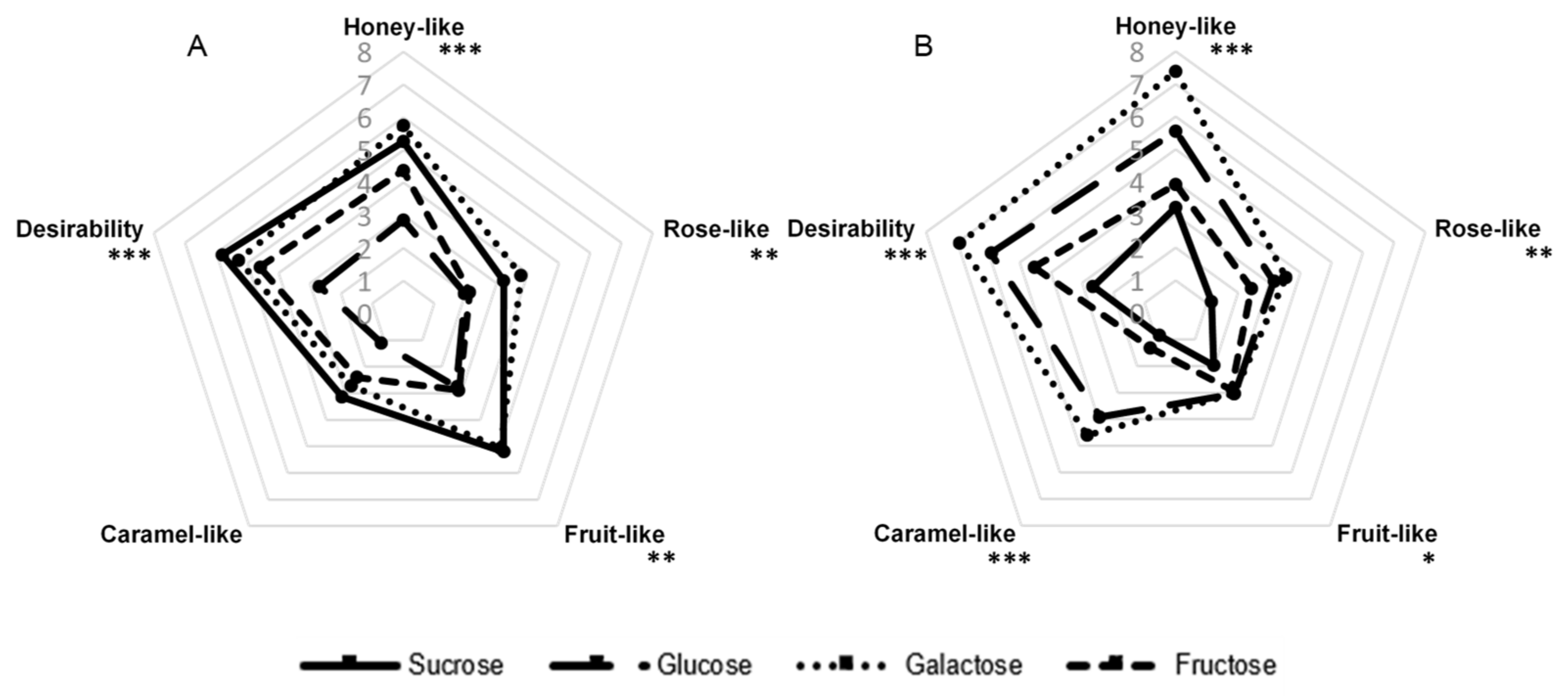
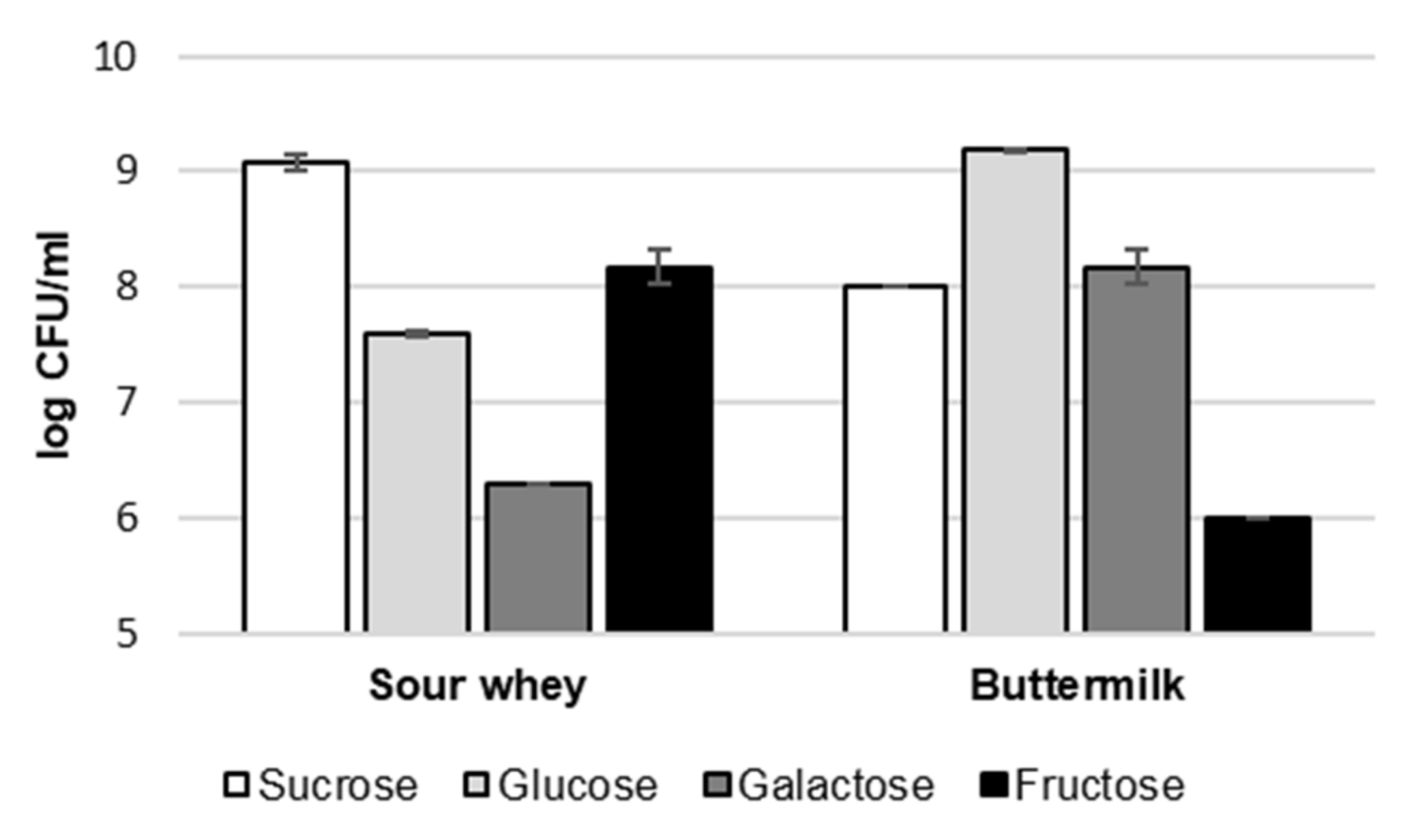
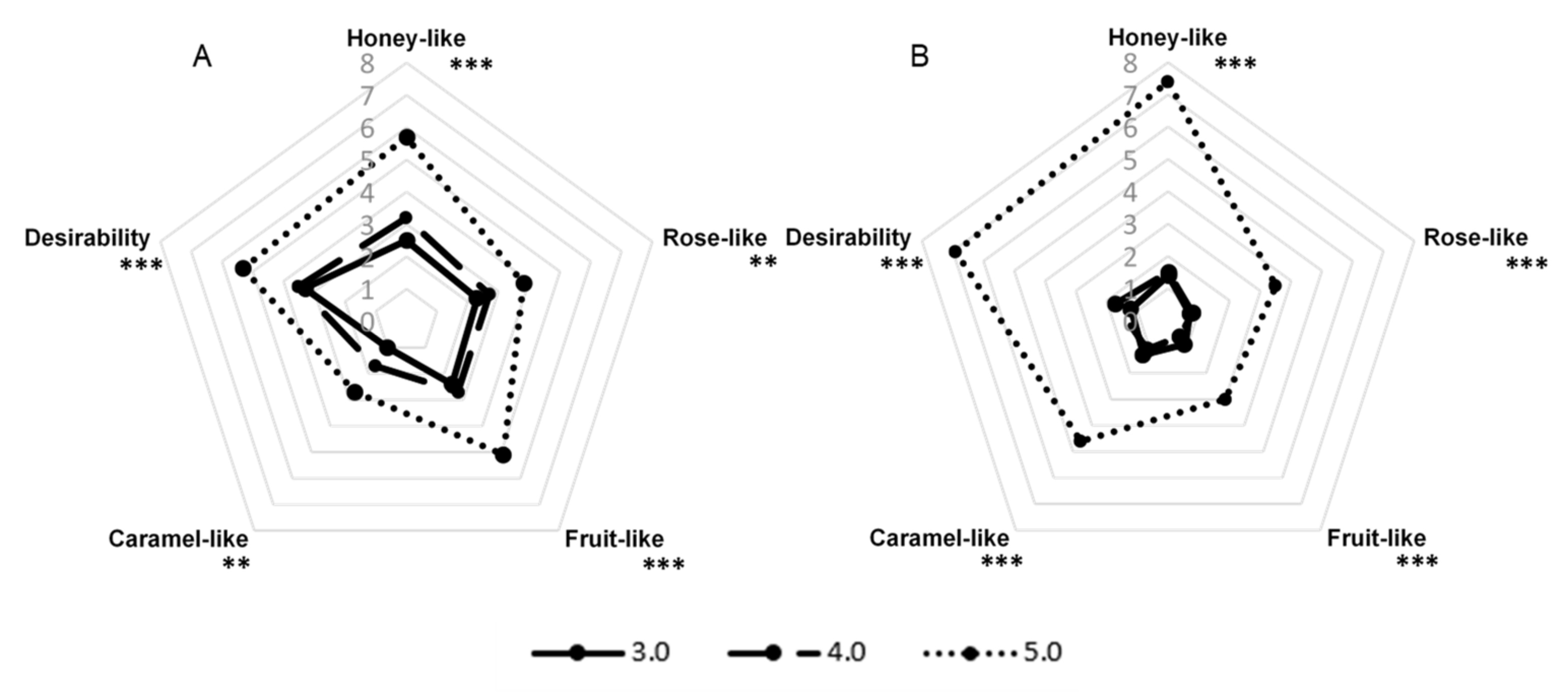
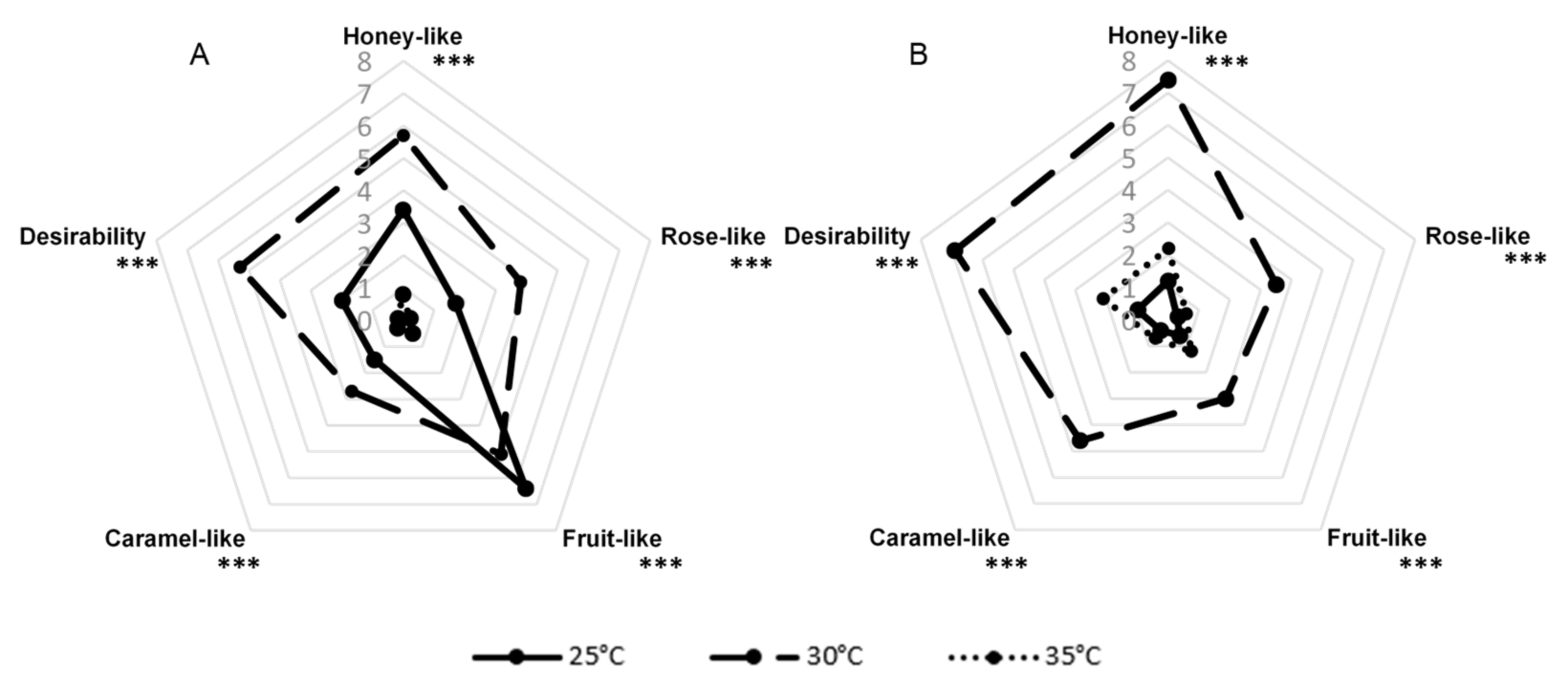
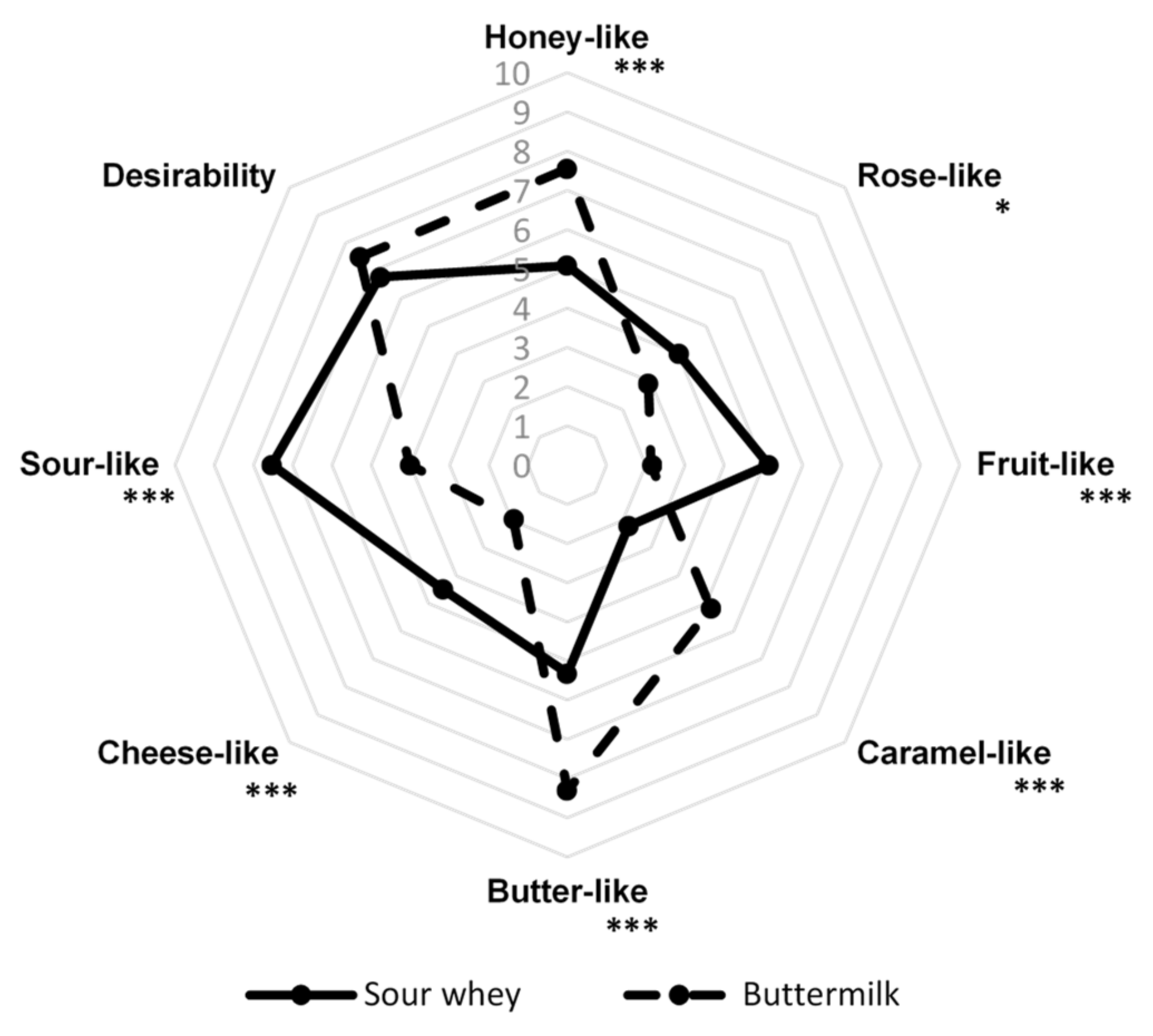
| Compound a | Odor b | RI-DB 5 c | RI-Wax c | Concentration (µg/kg) d | OT in Water (µg/kg) e | OAV f | ||
|---|---|---|---|---|---|---|---|---|
| Sour Whey | Buttermilk | Sour Whey | Buttermilk | |||||
| 2,3-butanedione | buttery | 670 | 991 | 370 | 680 | 15 | 25 | 45 |
| acetic acid | vinegar | 691 | 1445 | 127250 | 189780 | 99000 | 1.3 | 2.0 |
| 3-methylbutanal | malty | 695 | 948 | 38 | 36 | 0.5 | 76 | 72 |
| 3-methyl-1-butanol | fruity | 719 | 1204 | 146223 | 2730 | 980 | 149 | 2.8 |
| butanoic acid | cheesy | 836 | 1620 | 32040 | 13030 | 1000 | 32 | 13 |
| isovaleric acid | cheesy | 870 | 1665 | 19153 | 6286 | 490 | 39 | 13 |
| 3-(methylthio)-propanal | boiled potato | 908 | 1458 | 13 | 11 | 0.43 | 30 | 26 |
| dimethyl trisulfide | cabbage | 985 | 1377 | 0.6 | 1.5 | 0.099 | 6 | 15 |
| phenylacetaldehyde | honey | 1080 | 1644 | 1276 | 3650 | 4 | 319 | 912 |
| furaneol (4-hydroxy-2,5-dimethyl-3(2H)-furanone) | caramel | 1090 | 2025 | <LOD | <LOD | 87 | ||
| 2-phenylethanol | rosy | 1124 | 1920 | 125650 | 4653 | 240 | 524 | 19 |
| ethyl furaneol (2-ethyl-4-hydroxy-5-methylfurane-3(2H)-one) | burnt sugar | 1135 | 2080 | 28 | 326 | 17 | 1.6 | 19 |
| (E)-2-nonenal | fatty | 1160 | 1527 | 3.4 | 3.5 | 0.19 | 18 | 18 |
| Compound a | Quant. Ions b (m/z) b | Labeled Standards c | Ion IS (m/z) d |
|---|---|---|---|
| 2,3-butanedione | 86 | [13C4] 2,3-butanedione | 90 |
| acetic acid | 60 | [2H3] acetic acid | 63 |
| 3-methylbutanal | 86 | [2H3] 2-methylbutanal | 89 |
| 3-methyl-1-butanol | 70 | [2H2] 3-methyl-1-butanol | 72 |
| butanoic acid | 73 | [2H7] butanoic acid | 77 |
| 3-methyl butanoic acid | 87 | [2H2] 2-methyl butanoic acid | 89 |
| 3-(methylthio)-propanal | 104 | [2H5] 3-(methylthio)-propanal | 107 |
| dimethyl trisulfide | 126 | [2H6] dimethyl trisulfide | 132 |
| phenylacetaldehyde | 120 | [2H5] phenylacetaldehyde | 125 |
| furaneol (4-hydroxy-2,5-dimethyl-3(2H)-furanone) | 128 | [13C2] 4-hydroxy-2,5-dimethyl-3(2H)-furanone | 130 |
| 2-phenylethanol | 122 | [2H5] 2-phenylethanol | 127 |
| ethylfuraneol (2-ethyl-4-hydroxy-5-methylfurane-3(2H)-one) | 125 | [13C2] 4-hydroxy-2,5-dimethyl-3(2H)-furanone | 130 |
| (E)-2-nonenal | 140 | [2H2] (E)-2-nonenal | 142 |
Publisher’s Note: MDPI stays neutral with regard to jurisdictional claims in published maps and institutional affiliations. |
© 2021 by the authors. Licensee MDPI, Basel, Switzerland. This article is an open access article distributed under the terms and conditions of the Creative Commons Attribution (CC BY) license (https://creativecommons.org/licenses/by/4.0/).
Share and Cite
Szudera-Kończal, K.; Myszka, K.; Kubiak, P.; Majcher, M.A. Analysis of the Ability to Produce Pleasant Aromas on Sour Whey and Buttermilk By-Products by Mold Galactomyces geotrichum: Identification of Key Odorants. Molecules 2021, 26, 6239. https://doi.org/10.3390/molecules26206239
Szudera-Kończal K, Myszka K, Kubiak P, Majcher MA. Analysis of the Ability to Produce Pleasant Aromas on Sour Whey and Buttermilk By-Products by Mold Galactomyces geotrichum: Identification of Key Odorants. Molecules. 2021; 26(20):6239. https://doi.org/10.3390/molecules26206239
Chicago/Turabian StyleSzudera-Kończal, Kamila, Kamila Myszka, Piotr Kubiak, and Małgorzata Anna Majcher. 2021. "Analysis of the Ability to Produce Pleasant Aromas on Sour Whey and Buttermilk By-Products by Mold Galactomyces geotrichum: Identification of Key Odorants" Molecules 26, no. 20: 6239. https://doi.org/10.3390/molecules26206239
APA StyleSzudera-Kończal, K., Myszka, K., Kubiak, P., & Majcher, M. A. (2021). Analysis of the Ability to Produce Pleasant Aromas on Sour Whey and Buttermilk By-Products by Mold Galactomyces geotrichum: Identification of Key Odorants. Molecules, 26(20), 6239. https://doi.org/10.3390/molecules26206239







